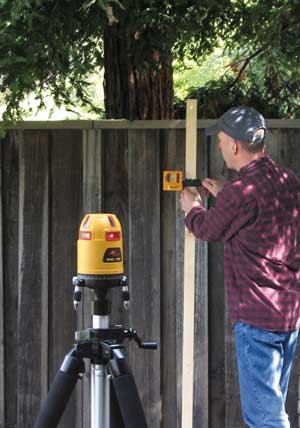Each model’s accuracy is provided by the manufacturer, typically in the range of +/-3/8 inch at 100 feet. I double-checked some of the claims and found them to be fairly accurate. All the tools performed adequately in this category. We most often used these lasers over distances of less than 30 feet, and one could argue that in a typical application their accuracy is actually closer to +/-1/8 inch or even less. This should satisfy most residential and light commercial standards.
You can increase the accuracy of your work by always marking the same part of the line. It’s up to you whether it’s the top, bottom, left, right, or center. This is less of an issue with better lasers because their beams tend to remain tightly focused over greater distances.
Accessories
All of the instruments come with some kind of case and a means of holding the units up off the ground so that you can see where the down beam hits the surface. The larger units – the Johnson, the PLS, and the Topcon LC-4X – have legs that can be adjusted slightly up and down to level the device. The legs on the Johnson model can be removed or folded out of the way for storage. Bosch’s laser requires no base because the beams that cross to form the down point are beyond the edge of the housing. Other tools include an accessory base that clips or screws to the bottom of the unit. Hilti’s base contains magnets that hold it against floor track to make it easier to plumb light-gauge steel walls. The others have magnets on the back so you can support the tool by sticking it to a steel stud or post.
Hilti’s laser comes with both a camera-style tripod and a bracket for hanging it from the wall or strapping it to a pipe or post. The brackets for two of the tools contain mechanisms for adjusting the elevation: Bosch’s sits on the floor or bolts to a tripod, and PLS’s hangs from the wall or clips to the track of a suspended ceiling.
All the tools can be mounted on tripods. The larger models (Johnson, PLS, and Topcon LC-4X) accept the 5/8-inch x 11 fittings used on standard construction tripods. If you don’t already own a construction tripod, it’s worth investing in one for outside work, because they’re stable on uneven ground. If the tool is designed to project sloped lines, you can get those lines by putting it on a video tripod and tilting the head to the desired angle. The Agatec, Hilti, Leica, and Topcon LC-2 models are tapped to fit the 1/4-inch x 20 fittings on camera and video tripods but can be adapted to construction tripods. The Bosch and the Spectra Precision will fit either type of tripod without an adapter.
Many lasers include special targets or glasses that make it easier to see the beams in bright ambient lighting. You wouldn’t think batteries would matter, but tools consume more power when they’re projecting more than one line. If you’re a heavy user you’ll go through a lot of batteries, so you might want to consider rechargeables. The PLS laser includes a charger, an AC adapter, and four rechargeable batteries. The Johnson includes a pair of power packs – one is rechargeable and the other takes AA batteries.
What to Buy?
